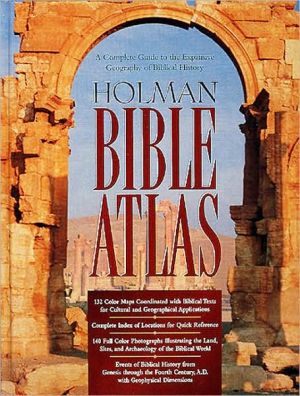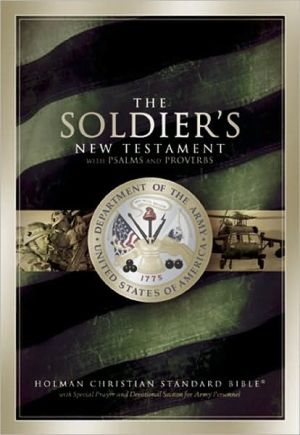Holman Bible Atlas: A Complete Guide to the Expansive Geography of Biblical History
The Holman Bible Atlas offers a visual feast through which the reader can explore the world of the Bible. Utilizing 140 full color maps key to biblical events and 140 full color photographs illustrating the land, sites, and archaeology of the biblical world, the Atlas draws the reader into the biblical story. The Holman Bible Atlas begins with an introduction to the geography of the biblical world emphasizing the major physical features of the Ancient Near East with special attention given to...
Search in google:
Acclaimed hardcover Bible atlas showcasing hundreds of maps and photographs that bring the settings of the Bible to life.
HOLMAN BIBLE ATLAS\ A Complete Guide to the Expansive Geography of Biblical History\ \ By Thomas C. Brisco\ HOLMAN REFERENCE\ \ Copyright © 1998 Thomas Brisco.\ All rights reserved.\ ISBN: 1-55819-709-5\ \ \ THE FACE OF THE ANCIENT NEAR EAST\ Most of the biblical drama unfolded in the Ancient Near East. Today the modern states of Egypt, Israel, Jordan, Saudi Arabia, Lebanon, Syria, Iraq, Iran, and Turkey occupy that area. The Ancient Near East has been called the "Cradle of Civilization" because many important cultural and technological advances took place there. We now know that comparable innovations occurred in other parts of the world, yet the Near East retains a central place in human history. There the influence of three continents—Africa, Asia, and Europe—converge.\ The Fertile Crescent\ James Breasted coined the phrase "Fertile Crescent" to describe a band of land where conditions favored the establishment of early agricultural settlements. Water, either from rainfall or irrigation, and a favorable climate encouraged the development of village life. Stretching northwest from the Persian Gulf (the "Lower Sea"), the crescent includes the lands bordering the Tigris and Euphrates Rivers known as Mesopotamia. In southern Turkey the crescent bends south along the eastern Mediterranean coast. Here lies a narrow strip of land caught between the sea and desert called the Levant. Ancient Syria formed the northern half of the Levant, while Palestine occupied the southernportion. The intrusion of the Syro-Arabian Desert from the south gives the crescent its characteristic shape, while mountain ranges (Taurus, Kurdistan, and Zagros Mountains) mark the limits to the north and east.\ Beyond the Sinai, south of the Fertile Crescent, lay Egypt. Favored by nature with the Nile River and its abundant water, Egypt played a vital part in the Ancient Near East. From about 3200 B.C., Egypt, like Mesopotamia, became a powerful center of civilization. Historically, the cultures of Egypt and Mesopotamia dominated the history of the Ancient Near East, at least until the campaigns of Alexander the Great (334-323 B.C.).\ The emergence of powerful and enduring civilizations in Egypt and Mesopotamia gave strategic importance to Palestine. Palestine was a "land bridge" linking the two great cultural centers. The major international route, the International Coastal Highway, crossed portions of Palestine. This geographical fact is crucial to the history of Palestine. As part of the corridor connecting Egypt and Mesopotamia, Palestine possessed a strategic importance far greater than its size or relatively few resources might suggest. Palestine sat astride the vital economic and military arteries of the Near East. Historically, this meant two things: (1) the people living in Palestine felt the imprint of many cultures, and (2) the major powers sought control of this small land.\ Mesopotamia: Home of Abraham\ Mesopotamia was an integral part of the biblical landscape in many periods. Genesis locates Abraham's homeland in Mesopotamia (Gen. 11-12). Mesopotamian kings from Assyria and Babylon appear frequently in the historical and prophetic books of the Old Testament. Jewish captives from Jerusalem spent many years in exile near Babylon. Descendants of those exiles were present at Pentecost.\ Mesopotamia, literally the land "between the rivers," describes those lands bordering the Tigris and Euphrates Rivers. Today Iraq, northern Syria, and extreme southeastern Turkey occupy the area of ancient Mesopotamia. To the south and west the great expanse of the Syro-Arabian desert forms the border beyond which settled life based on agriculture is not possible. To the north and east, mountains ring Mesopotamia. In Bible times these mountains harbored less-advanced peoples who often threatened Mesopotamian kingdoms. Mesopotamia gave birth to many great civilizations, including the Sumerian, Akkadian, Babylonian, and Assyrian.\ TIGRIS AND EUPHRATES\ The Tigris and Euphrates Rivers dominate Mesopotamia. Both rivers originate in the high mountains of eastern Turkey and flow south-southeastward to the Persian Gulf. Large distances separate the rivers for most of their journey, but near Baghdad they converge to within twenty miles of each other before diverging again. Near the head of the Persian Gulf, the rivers merge into a marshland, a feature characteristic of both ancient and modern times. The Euphrates (1,780 miles long) is longer and slower than the Tigris, but more suited for transportation. Two major tributaries, the Balikh and Habor, join the Euphrates in northwest Mesopotamia. The Tigris (1,150 miles long) is much swifter, descending through the steppes running parallel to the Zagros Mountains. Four tributaries—the Greater and Lesser Zab, the Adhem, and the Diyala—enter the Tigris from these mountains. The influence of the Tigris and Euphrates, with their tributaries, is such that virtually all important cities of Mesopotamia can be found along their courses. Indeed, whenever a river changed its course, as the Euphrates on occasion did, it isolated the cities, which then declined or were abandoned for economic reasons.\ Both the Tigris and Euphrates flooded annually. Autumn and winter rains in combination with melting snows of the high northern mountains produced a large volume of water that had to be harnessed. This inundation was unpredictable, at times being inadequate and at other times, violent. The timing of the flood in Mesopotamia was not as helpful for agriculture as in Egypt. Consequently, the inhabitants of central and southern Mesopotamia maintained a sophisticated system of canals, dikes, and dams from earliest times to protect their cities and to distribute water to thirsty fields. Ancient flood stories like the Gilgamesh Epic abounded in Mesopotamia. They expressed the ancients' fascination with and fear of these floods.\ NORTH AND SOUTH MESOPOTAMIA\ Northern and southern Mesopotamia differ in terms of geography, climate, and natural resources. The dividing line between the two sections is roughly near modern Baghdad. The southern portion from Baghdad to the Persian Gulf (approximately 350 miles by scale) is a flat plain formed by sediments deposited by the rivers and soil blown from the desert. Summers here are very hot (95°F average in July), but winters are mild. Rainfall is scarce, decreasing the farther south one goes; thus crops have depended entirely on irrigation. Still visible from the air are the numerous irrigation canals, long since silted up, required for agriculture. This intense irrigation and flooding resulted in an increase in the salt content of the land (salinization), which eventually hindered crop production.\ Southern Mesopotamia lacks many resources. Few building materials were available; houses, temples, and palaces were all built of mud brick. Metals and timber had to be imported. However, the irrigated fields produced excellent crops of barley, the basic staple used for cakes and beer, and some wheat. Dates, which grew in abundance, and sesame oil supplied essential carbohydrates for the diet. Fish from the marshlands and rivers provided much of the meat. Properly utilized, this land supported a significant population, with surpluses for export. Successively, the Sumerian, Akkadian, and Babylonian civilizations arose in southern Mesopotamia, bequeathing a great cultural heritage to the Near East. Cities like Babylon and Ur testify to the land's vitality.\ North of Baghdad, uplands and steppes contrast with the flat plain of the south. Rolling hills emerge from the high mountains that border Mesopotamia to the north. Rainfall amounts are higher here, with some sections receiving up to twenty inches annually, although many areas receive much less. The summers are somewhat milder than in the south, but winters are harsher due to higher elevations.\ Near Mosul in the Middle Tigris Valley, Asshur, Nineveh, and Calah (Nimrud) mark the heartland of ancient Assyria. Timber and building stones offered royal architects materials for the impressive palaces, temples, and administrative centers of the Assyrian kings; however, common people used mud brick for their houses.\ Portions of Assyria produced crops of barley and wheat, but seldom in quantities to be totally self-sufficient. Also, the metals necessary for weapons and implements—copper, iron, tin, zinc, and lead—had to be imported along with cedar and supplemental food supplies. This meant that the Assyrians often sought to expand their control southward to Babylonia or westward to the Mediterranean Sea to obtain vital commodities through major trade routes.\ Due west of Assyria lay northwest Mesopotamia with its grassy steppes and fertile lands associated with the Balikh and Habor Rivers. Abundant winter rains, a high water table, and numerous small streams make this region especially attractive for raising cattle and sheep. The Bible associates Abraham closely with this region. The biblical term Aram-naharaim (Gen. 24:10; Deut. 23:4), often translated "Mesopotamia," refers to the land of the Balikh and Habor Rivers.\ Egypt: Land of Bondage\ As the home of one of the world's enduring civilizations, Egypt looms large on the biblical landscape. For over three thousand years Egyptian history unfolded, casting its spell over the ancient world. By the time Abraham journeyed to Egypt, the pharaohs had ruled for over a thousand years. With its close geographical proximity, this ancient culture left a deep impression on the people of Palestine. The biblical references concerning Joseph and Moses illustrate the interconnections between the lands. Egyptian kings repeatedly meddled in the affairs of Palestine, attempting to exploit key trade routes and maintain a buffer zone of security.\ THE TWO LANDS\ The land that spawned such a vital civilization is geographically unique. Egypt is "the gift of the Nile," observed the Greek historian Herodotus in the fifth century B.C. The waters of the Nile extend like a finger of life through the stone and sand of North Africa's deserts. From the first cataract near Aswan northward 750 miles to the Mediterranean Sea, ancient Egypt comprised the arable land touched by the Nile.\ Geographically, Egypt consisted of two distinct parts, with the dividing line near modern Cairo. North of Cairo, the Nile formed a great Delta composed of deep alluvial sediments deposited through the millennia. Several branches of the Nile flowed through the Delta, or "Lower Egypt," in antiquity, although only two remain today. Dense undergrowth prevented development in earlier times, but eventually several key cities emerged, such as Sais, Bubastis, and the biblical store cities of Pithom and Raamses (Exod. 1:11). The northeastern Delta, the part of Egypt most readily accessible to Palestine, is the land of Goshen to which the patriarchs frequently traveled (Gen. 45:9-11; 46:31ff).\ South of Cairo, the encroaching deserts restrict settlement to the Nile Valley, a narrow ribbon of land affected by the annual flood on either side of the river. The Nile Valley, or "Upper Egypt," never is more than a few miles wide. Scattered along the banks of the Nile, the great Egyptian cities with their monumental temples still inspire awe. Abydos, Edfu, and especially Thebes (biblical No-amon), with its temple of Amon-Re, embodied the power of Egypt in her era of greatest strength. Opposite Thebes in the cliffs of the western desert, the pharaohs of the New Kingdom carved their tombs in the Valley of the Kings. These Egyptian cities tended to be smaller than their Mesopotamian counterparts; in fact, most Egyptians lived in small villages. Still, through the centuries Egypt's monumental architecture, not normal village life, has gripped the imaginations of historian and poet alike.\ THE GIFT OF THE NILE\ Egypt's greatest resource was the Nile, which linked the cities and villages along its length. The Nile provided transportation and communication as the principal highway of the land. Natural currents carried traffic northward, while prevailing north winds permitted travel upriver (southward). The annual inundation of the Nile provided the river's chief benefit to the land. Each year, with uncanny regularity, the Nile flooded, replenishing the land with water and a thin layer of new soil. The causes of this unique phenomenon are found far to the south of Egypt.\ The Nile is a composite river that draws water from several different streams. The White Nile provides a steady source of water from the lakes of equatorial Africa that are fed by constant rains. Near Khartoum in the Sudan, two other rivers—the Blue Nile and the Atbara—join the White Nile. During the spring, melting snows and rains in the Ethiopian highlands swell the Blue Nile and the Atbara with water, their swift currents carrying soil and organic materials. The Nile rises as their waters rush northward toward the Mediterranean.\ From July to September the waters covered the land along the river's banks, soaking the fields and depositing a layer of rich silt. When the waters retreated, the Egyptian farmers reestablished the boundaries of their fields and prepared the land for planting. Since all agriculture depended on the annual flood, the Egyptians developed devices (Nilometers) to predict its height. A rise of seven to eight meters was ideal. A higher flood could be destructive, while a rise of less than six meters could provoke a famine like that mentioned in Genesis 41:53.\ The annual inundation of the Nile was one of several factors that gave stability to Egyptian civilization. A favorable climate was another. Although rainfall is sparse throughout the land and summer temperatures can be very hot, the long sunny days and mild winters were ideal for growing crops. Egypt was immune from the storms and extreme variations of climate found in other parts of the Near East. Moreover, deserts bordered the land of Egypt on the east and west, while the Mediterranean Sea was an effective barrier to the north.\ Six cataracts in the Nile River to the south, protected by strategically fortified garrisons, controlled any approach to Egypt from that direction. Access to Egypt came primarily through the northeast Delta. Here the great trade routes crossing the Sinai from Palestine entered Egypt, linking the land with the other cultures of the Near East. Those same trade routes could be used to attack Egypt as well. Consequently, the Egyptians repeatedly sought to extend their control beyond Sinai into Palestine and Syria, thereby ensuring security and an enduring connection to vital goods.\ The Levant\ The term "Levant" describes the habitable land along the eastern Mediterranean coast sandwiched between the Mediterranean Sea on the west and the Syro-Arabian Desert to the east. Syria and Lebanon comprised the northern sections of the Levant while Palestine (see chap. 2) anchored the southern end. The Levant served as a land bridge, connecting the great cultural centers located in Mesopotamia and Egypt. The great trunk route—the International Coastal Highway—followed the natural passageway through the region. Although not blessed with large rivers, most sections of the Levant normally received adequate rainfall for crop production, while several smaller rivers interspersed between higher mountains provided additional water.\ SYRIA AND LEBANON\ The modern states of Syria and Lebanon occupy most of the northern Levant today, although portions lay in southern Turkey. The Amanus Mountains (up to 7,000 feet) marked the northern limits of ancient Syria. A pass through these mountains led to the Cilician Plain which in turn gave access up to the Anatolian Plateau through the Taurus Mountains via the vital Cilician Gates. Syria proper lay south and west of the Euphrates River. The great city of Carchemish, on the Euphrates, connected Syria with Assyria by way of Haran across the steppe land known as Al-Jazirah. A series of mountains dominates Syria's western sector along the coast including the Amanus Mountains, the Nuseiriyeh Mountains (up to 5,300 feet), and Mons Cassius (5,771 feet). The Orontes River descends from the Beqa Valley, emptying into the Plain of Antioch. Ancient Ugarit, where excavations yielded important religious texts detailing the myths of Baal, was a key Syrian port. Inland, the International Coastal Highway passed through Hamath, Ebla, and Aleppo, all lying in valleys and plains east of the mountains. Caravans traversed the Syrian desert along an important route that connected Mari with Damascus by way of Tadmor/Palmyra, one of the great caravan cities of the ancient world. The great Syrian Desert tableland south and east of this caravan route made travel virtually impossible.\ (Continues...)\ \ \ Excerpted from HOLMAN BIBLE ATLAS by Thomas C. Brisco. Copyright © 1998 by Thomas Brisco. Excerpted by permission. All rights reserved. No part of this excerpt may be reproduced or reprinted without permission in writing from the publisher.\ \







